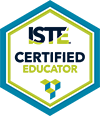

Event Information
1. Introduction and Overview (5 minutes)
Introduction of the engineering design challenge and explain that participants will experience the lesson from a student’s perspective.
2. Setting Up the Engineering Challenge (10 minutes)
Participants, acting as students, are tasked with designing an accessible tool for students with disabilities (e.g., an assistive device for a student with mobility issues or a classroom tool that supports students with visual impairments).
3. Brainstorming and Research (10 minutes)
Participants (acting as students) use their digital notebooks to brainstorm possible solutions for their assigned accessibility challenge. They will research existing solutions and document their ideas within the notebook.
4. Designing the Solution (20 minutes)
Participants will work on creating a design for their accessible tool using the digital notebook to sketch, draft, and outline their prototype. Encourage the use of multimedia tools within the notebook to support the design process (e.g., inserting diagrams, voice memos, or using embedded 3D modeling tools).
5. Documenting and Reflecting (10 minutes)
Participants will complete a reflection on their design process within the digital notebook, using prompts such as:
How did the digital notebook enhance your ability to document your design process?
How did the inclusive features of the notebook support your learning?
What accessibility features did you incorporate into your design?
6. Peer Feedback and Sharing (10 minutes)
Participants will share their designs and reflections with the group, simulating a classroom presentation. The digital notebook will be used to project their designs and annotations.
7. Wrap-Up and Discussion (5 minutes)
Group discussion about the experience. Ask participants to reflect on how the digital interactive notebook supported inclusivity compared to a traditional paper notebook.
Key Questions:
How did the digital tools enhance your design process?
What features of the digital notebook were most beneficial for accessibility and inclusivity?
How could you incorporate these tools into your own classroom?
Engagement Strategies Used Throughout the Lesson
Live Polling: Used at the beginning to gauge participants' experience and understanding.
Hands-On Activities: Participants will engage in a simulated student experience by completing an engineering design challenge using digital notebooks.
Peer Collaboration: Participants will collaborate in real-time using the digital notebook's features, modeling how students can work together on projects.
Reflection and Sharing: Participants will reflect on their learning process and provide feedback, demonstrating how digital notebooks facilitate reflection and peer interaction in a more inclusive way than traditional methods.
Multimodal Learning: Participants will experience firsthand how digital notebooks support diverse learning preferences through text, audio, video, and collaborative features.
By the end of the session, participants will have experienced a complete engineering design challenge while exploring how digital notebooks can create a more inclusive, engaging, and accessible learning environment.
CAST: Universal Design for Learning (UDL) Guidelines
A foundational resource outlining how UDL can be used to design inclusive learning environments that accommodate diverse learner needs.
5E Science Instruction:
https://www.edutopia.org/article/how-use-5e-model-your-science-classroom/
Effective Science Instruction:
https://files.eric.ed.gov/fulltext/ED521576.pdf

